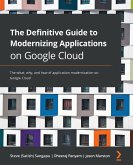In 2016, Microsoft introduced the new generation of .NET called .NET Core. It brought many fundamental improvements to the platform, but there were also many breaking changes and missing APIs, especially when it comes to creating web applications. Upgrading any website running on .NET Framework to the new .NET Core proved to be a complex process, which can take months or even years.
This book describes two approaches you can take to incrementally modernize legacy .NET web applications. It explains the changes that happened in ASP.NET MVC, ASP.NET Web API, Entity Framework, ASP.NET Identity, SignalR, and other libraries. It also shows a migration path for applications written in ASP.NET Web Forms: a technology which isn't supported in the new .NET at all.
In addition, the book describes the new frameworks available in the ASP.NET Core platform (Blazor, Razor Pages, ASP.NET Core MVC, SignalR Core, and so on) and helps you decide which technology will be the best fit.
The book also covers several "soft" areas: how to explain the benefits or necessity for the modernization to your company management, how to deal with refactoring and improving the overall code quality during the entire process, and how to adjust the architecture of the application to be ready for another technology upgrade in the future.
The topic of modernization is highly relevant. There are still plenty of legacy .NET applications that are being actively developed and maintained. Many of them were developed for 10+ years, they involve plethora of company-specific know-how, and it is not economically feasible to rewrite them from scratch.
What You Will Learn
Discover the changes you need to make in a legacy ASP.NET application to migrate it to .NET 8 and beyondEstimate the required effort and prepare the entire processUse the In-place or Side-by-side approach to modernize your application incrementallyMigrate from ASP.NET Web Services or WCFto REST or gRPCMigrate from ASP.NET SignalR to SignalR Core or from Entity Framework to EF CoreMigrate from Forms Authentication to ASP.NET IdentityMigrate ASP.NET Web Forms to Blazor Server or DotVVMMigrate ASP.NET MVC and Web Pages to ASP.NET Core MVC and Razor PagesRefactor and clean up your codebase to make it more maintainable
Who This Book Is For
.NET developers who work with ASP.NET web applications running on the .NET framework, and tech leads and software architects who make technical decisions about legacy .NET projects used in their organization
Hinweis: Dieser Artikel kann nur an eine deutsche Lieferadresse ausgeliefert werden.
This book describes two approaches you can take to incrementally modernize legacy .NET web applications. It explains the changes that happened in ASP.NET MVC, ASP.NET Web API, Entity Framework, ASP.NET Identity, SignalR, and other libraries. It also shows a migration path for applications written in ASP.NET Web Forms: a technology which isn't supported in the new .NET at all.
In addition, the book describes the new frameworks available in the ASP.NET Core platform (Blazor, Razor Pages, ASP.NET Core MVC, SignalR Core, and so on) and helps you decide which technology will be the best fit.
The book also covers several "soft" areas: how to explain the benefits or necessity for the modernization to your company management, how to deal with refactoring and improving the overall code quality during the entire process, and how to adjust the architecture of the application to be ready for another technology upgrade in the future.
The topic of modernization is highly relevant. There are still plenty of legacy .NET applications that are being actively developed and maintained. Many of them were developed for 10+ years, they involve plethora of company-specific know-how, and it is not economically feasible to rewrite them from scratch.
What You Will Learn
Discover the changes you need to make in a legacy ASP.NET application to migrate it to .NET 8 and beyondEstimate the required effort and prepare the entire processUse the In-place or Side-by-side approach to modernize your application incrementallyMigrate from ASP.NET Web Services or WCFto REST or gRPCMigrate from ASP.NET SignalR to SignalR Core or from Entity Framework to EF CoreMigrate from Forms Authentication to ASP.NET IdentityMigrate ASP.NET Web Forms to Blazor Server or DotVVMMigrate ASP.NET MVC and Web Pages to ASP.NET Core MVC and Razor PagesRefactor and clean up your codebase to make it more maintainable
Who This Book Is For
.NET developers who work with ASP.NET web applications running on the .NET framework, and tech leads and software architects who make technical decisions about legacy .NET projects used in their organization
Hinweis: Dieser Artikel kann nur an eine deutsche Lieferadresse ausgeliefert werden.








